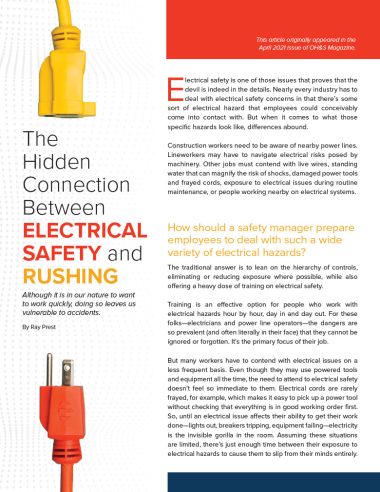This article by Ray Prest was originally published in the
April 1, 2021 issue of Occupational Health & Safety.
Electrical safety is one of those issues that proves that the devil is indeed in the details. Nearly every industry has to deal with electrical safety concerns in that there’s some sort of electrical hazard that employees could conceivably come into contact with. But when it comes to what those specific hazards look like, differences abound.
Construction workers need to be aware of nearby power lines. Lineworkers may have to navigate electrical risks posed by machinery. Other jobs must contend with live wires, standing water that can magnify the risk of shocks, damaged power tools and frayed cords, exposure to electrical issues during routine maintenance, or people working nearby on electrical systems.
How should a safety manager prepare employees to deal with such a wide variety of electrical hazards? The traditional answer is to lean on the hierarchy of controls, eliminating or reducing exposure where possible, while also offering a heavy dose of training on electrical safety.
Training is an effective option for people who work with electrical hazards hour by hour, day in and day out. For these folks—electricians and power line operators—the dangers are so prevalent (and often literally in their face) that they cannot be ignored or forgotten. It’s the primary focus of their job.
But many workers have to contend with electrical issues on a less frequent basis. Even though they may use powered tools and equipment all the time, the need to attend to electrical safety doesn’t feel so immediate to them. Electrical cords are rarely frayed, for example, which makes it easy to pick up a power tool without checking that everything is in good working order first. So, until an electrical issue affects their ability to get their work done—lights out, breakers tripping, equipment failing—electricity is the invisible gorilla in the room. Assuming these situations are limited, there’s just enough time between their exposure to electrical hazards to cause them to slip from their minds entirely.
And that brings me to the topic of rushing. Yes, rushing. Bear with me for a moment while I explain.
Speed Doesn’t Equal Efficiency
It’s no secret that people are more likely to suffer an injury if they’re moving at a faster pace than usual. Every single task we perform, from operating a table saw to carrying laundry down the stairs, becomes more dangerous if we’re moving quickly or in a rush.
Rushing makes us more likely to make a physical mistake. It also makes us more likely to skip a step and—take note here—overlook hazards we might otherwise spot. Being in a hurry isn’t a guarantee that an incident will occur, but you know as well as I do that the risk needle only needs to move a little for it to cause an uptick in incidents.
So what does rushing have to do with electrical safety? A lot, actually—especially for workers whose primary job is not dealing with electrical matters. And it turns out that while rushing is a major problem, it may also offer some surprising avenues to reducing electrical injuries.
If rushing is defined as going fast enough to potentially overlook hazards, then workers rush through electrical safety tasks all the time. Think of all the instances when someone failed to check the condition of an electrical connection or didn’t double-check how close they were to an overhead wire or buried power line. Think of all the wet hands and small puddles that workers don’t recognize as shock potential in the moment.
All of that? Yes, it’s rushing. And just like with speeding on the highway, it happens for a variety of reasons, from people thinking that they can adequately control the risk (even though they can’t) to a sense of urgency pushing them to go faster despite the danger.
Often, it’s also a matter of complacency making the increased pace and risk feel comfortable.
Every worker needs to be properly educated on the electrical hazards they may face over the course of their job, but this type of training tends to be informational, which makes it ill-suited to overcome rushing and other factors like complacency. Because workers who know the hazards can still speed through their tasks without noticing an exposed wire in the equipment they’re using.
Rushing is a lot like electrical hazards in that it affects almost everyone, and appears in a shocking variety of ways. But whereas electrical safety has a thousand permutations (many of which are situation-specific), rushing is quite the opposite.
The skills and knowledge required for workers to recognize when they’re rushing are the same in almost any context, which means it can protect them from coming into contact with electricity. (This makes it particularly useful for construction workers and other folks who must contend with a wide variety of electrical-based hazards.)
But people rarely develop these skills and knowledge on their own—they need to be trained on them. And they need to be given plenty of support too. To further insulate your workers from electrical hazards, you should educate them on human factors and keeping electrical risks front of mind.
Human Factors Education
Everyone knows what it feels like to be in a rush. Typically, our heart rate elevates, we move more rapidly, maybe there’s a little adrenaline spike, and our minds (and sometimes our eyes) start looking ahead to the next task rather than focusing on what we’re currently doing.
No one needs to be taught this. But knowing what it feels like doesn’t do us much good if we aren’t aware of the dangers rushing poses—that taking our eyes and mind off the job at hand can quickly lead to an injury. It’s also helpful if we have practice in slowing down when we find ourselves rushing. It’s even better if we can anticipate when we’re likely going to be rushing and then take steps to compensate accordingly.
This seems pretty simple: Tell people to slow down and pay attention, right? Unfortunately, without a strong grasp of why it’s so important, plus a solid foundation of practice, this type of messaging will be effective for fifteen minutes, give or take. It’s the same as telling children to be careful when they’re in the middle of playing. It’s not realistic to expect rushing to ever go away with a simple instruction, which means it will need to be managed.
And something so ingrained and intuitively simple will need to be regulated and offset with an equal amount of thinking and practice, sort of like Newton’s Third Law of Motion.
These types of awareness skills and safety knowledge are best delivered through formal training and lots of structured practice, communication and reinforcement. Rushing falls under the umbrella of human factors—physical and mental states that affect our thoughts and actions. A rigorous human factors education program will ground workers in a basic understanding of rushing, and other factors like distraction and fatigue, while also providing practical tactics to deal with these issues in real time.
One major ancillary benefit—human factors training applies to all aspects of rushing. It will boost employees’ ability to spot electrical hazards, and it will also reduce the likelihood that someone will trip while hustling to the break room, make an error while trying to finish a task at the end of the day, or get into a speed-related crash on their drive home.
Keep Risks Front of Mind
Understanding the ins and outs of human factors is incredibly important. So is keeping that knowledge front of mind for workers, especially when they’re still learning to put their human factors or awareness training into practice.
The standard playbook for reinforcing safety information applies here: posters, toolbox talks and short bursts of refresher training are all effective options. But there’s one caveat. Rushing is frequently situational. Therefore, one of the best methods of preparing workers to recognize rushing is through situation-based conversations.
To do that, talk about hypothetical situations, ask what-if questions (“What will you do if you notice the internal urge to hurry up and get this task done?”) and talk about the daily scenarios when workers are most likely to overlook electrical hazards because they’re in a rush. Ask open-ended questions and let employees rely on their own expertise. They know better than anyone what their days look like, and every worker can tell you how the risks posed by rushing fluctuate.
Once people start recognizing when they’re rushing, they become able to switch their focus in the moment to safety and consider what risks they might be overlooking, or what they need to pay attention to while they complete the work—especially if slowing down isn’t a realistic option.
This is where electrical safety training can mesh with human factors training. For instance, when teaching people who work with corded tools about electrical safety, you can ask them to add a quick visual inspection of the cord as one of the items on their short mental checklist when they pause to reflect on their rushing. Now you’ve made the invisible gorilla more visible, since rushing occurs so much more frequently than a frayed cord.
And once supervisors understand the implications of human factors, they’re less likely to make demands of workers that will cause them to rush. They may also learn to offer safety reminders, look for hazards themselves, or make sure electrical or other issues are dealt with proactively. And when frontline leaders start supporting workers to use their human factors skills and knowledge to recognize electrical safety issues, you’ll be well on your way to drastically reducing the number of electricity-related injuries in your workforce.
Ray Prest is the Director of Marketing at SafeStart, a safety company focused on human factors solutions that reduce preventable death and injuries on and off the job. A columnist for Safety Decisions since 2015, Ray’s been helping people learn about safety and training for over 20 years. Read more at safestart.com/ray.

Get the PDF version
You can download a printable PDF of the article using the button below.

